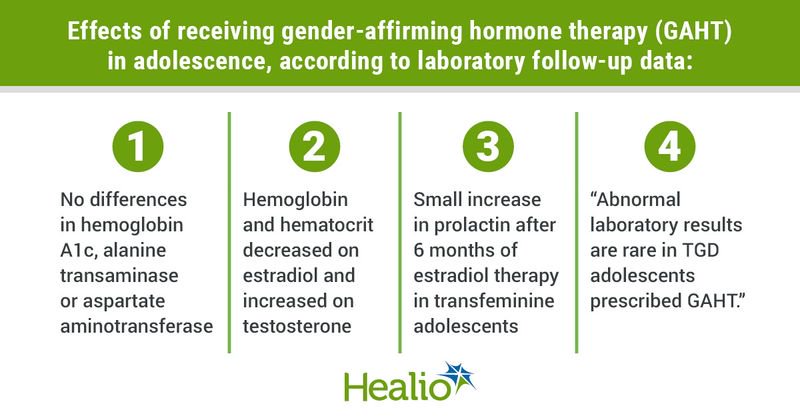Abnormal lab results rare in teens on gender-affirming hormone therapy
Key takeaways:
- Adolescents continue to be healthy throughout gender-affirming hormone therapy.
- Different standards for BMI, weight and lab ranges could be helpful for transgender patients.
Abnormal laboratory results are rare among adolescents receiving gender-affirming hormone therapy, according to study results published in Pediatrics.
“There has and still is concern that because [gender-affirming hormone therapy, or GAHT] is relatively new and becoming more common, that we there wasn't a lot of data about what the outcomes would be in terms of the lab changes,” Kate Millington, MD, a pediatric endocrinologist at Hasbro Children’s Hospital in Providence, Rhode Island, and co-author of the study, told Healio.

For that reason, Millington said, common guidelines on what to check and when to check were often based on studies with either transgender adults undergoing hormone therapy or on similar conditions that can be treated with hormones, such as hypogonadism or acne.
“We wanted to create a set of standards for kids who are actually being treated for their gender, to understand how the labs would change to help to guide clinicians,” Millington said.
The researchers began in 2017 by approaching patients who were presenting to gender clinics for gender-affirming care that included GAHT and inviting them to participate in the study. They followed up with the participants at 6, 12 and 24 months.
“At each of those time points, the study participants went through a battery of psychological questioning and analysis,” Millington said. “They also had their medical record reviewed. The lab data that we published on was labs that had already been in the medical record.”
Among 293 participants without a history of gonadotropin-releasing hormone analog use, 68% were designated female at birth. Hemoglobin decreased by 1.4 mg/dL and hematocrit by 3.6% within 6 months among adolescents prescribed estradiol, whereas hemoglobin and hematocrit increased by 1 mg/dL and 3.9%, respectively, among adolescents prescribed testosterone by 6 months after initiation.
The researchers found no differences in hemoglobin A1c, alanine transaminase or aspartate aminotransferase, although they did find a slight increase in prolactin after 6 months of estradiol therapy in transfeminine adolescents.
“It's actually very important to publish that the labs don't change, and that these kids are healthy and that they continue to be healthy throughout their treatment,” Millington said. “The other takeaway here is that if there are abnormal labs, it's actually very uncommon, and most of the time — if not all of the time — if there is an abnormality, it usually self-resolves”
In the future, Millington said, it will be important to establish growth charts, BMI charts, weight charts and normal laboratory ranges for people who are transgender.
“I think we do need to establish norms that are for transgender individuals uniquely, rather than just kind of borrowing the norms from cisgender individuals,” Millington said.

